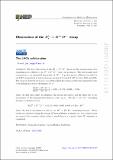| dc.contributor.author | Aaij, R. | |
| dc.contributor.author | Abdelmotteleb, A. S. W. | |
| dc.contributor.author | Abellan Beteta, C. | |
| dc.contributor.author | Abudinén, F. | |
| dc.contributor.author | Ackernley, T. | |
| dc.contributor.author | Adeva, B. | |
| dc.contributor.author | Adinolfi, M. | |
| dc.contributor.author | Adlarson, P. | |
| dc.contributor.author | Afsharnia, H. | |
| dc.contributor.author | Agapopoulou, C. | |
| dc.contributor.author | Aidala, C. A. | |
| dc.contributor.author | Aiola, S. | |
| dc.contributor.author | Ajaltouni, Z. | |
| dc.contributor.author | Akar, S. | |
| dc.contributor.author | Akiba, K. | |
| dc.contributor.author | Albrecht, J. | |
| dc.contributor.author | Alessio, F. | |
| dc.contributor.author | Alexander, M. | |
| dc.date.accessioned | 2023-07-17T13:38:24Z | |
| dc.date.available | 2023-07-17T13:38:24Z | |
| dc.date.issued | 2023-07-13 | |
| dc.identifier.uri | https://hdl.handle.net/1721.1/151124 | |
| dc.description.abstract | Abstract
The first observation of the
B
s
0
$$ {B}_s^0 $$
→ D∗+D∗− decay and the measurement of its branching ratio relative to the B0 → D∗+D∗− decay are presented. The data sample used corresponds to an integrated luminosity of 9 fb−1 of proton-proton collisions recorded by the LHCb experiment at centre-of-mass energies of 7, 8 and 13 TeV between 2011 and 2018. The decay is observed with more than 10 standard deviations and the time-integrated ratio of branching fractions is determined to be
B
B
s
0
→
D
∗
+
D
∗
−
B
B
0
→
D
∗
+
D
∗
−
=
0.269
±
0.032
±
0.011
±
0.008
,
$$ \frac{\mathcal{B}\left({B}_s^0\to {D}^{\ast +}{D}^{\ast -}\right)}{\mathcal{B}\left({B}^0\to {D}^{\ast +}{D}^{\ast -}\right)}=0.269\pm 0.032\pm 0.011\pm 0.008, $$
where the first uncertainty is statistical, the second systematic and the third due to the uncertainty of the fragmentation fraction ratio fs/fd. The
B
s
0
$$ {B}_s^0 $$
→ D*+D*− branching fraction is calculated to be
B
B
s
0
→
D
∗
+
D
∗
−
=
2.15
±
0.26
±
0.09
±
0.06
±
0.16
×
10
−
4
,
$$ \mathcal{B}\left({B}_s^0\to {D}^{\ast +}{D}^{\ast -}\right)=\left(2.15\pm 0.26\pm 0.09\pm 0.06\pm 0.16\right)\times {10}^{-4}, $$
where the fourth uncertainty is due to the B0 → D*+D*− branching fraction. These results are calculated using the average
B
s
0
$$ {B}_s^0 $$
meson lifetime in simulation. Correction factors are reported for scenarios where either a purely heavy or a purely light
B
s
0
$$ {B}_s^0 $$
eigenstate is considered. | en_US |
| dc.publisher | Springer Berlin Heidelberg | en_US |
| dc.relation.isversionof | https://doi.org/10.1007/JHEP07(2023)119 | en_US |
| dc.rights | Creative Commons Attribution | en_US |
| dc.rights.uri | http://creativecommons.org/licenses/by/4.0/ | en_US |
| dc.source | Springer Berlin Heidelberg | en_US |
| dc.title | Observation of the B s 0 $$ {B}_s^0 $$ → D*+D*− decay | en_US |
| dc.type | Article | en_US |
| dc.identifier.citation | Journal of High Energy Physics. 2023 Jul 13;2023(7):119 | en_US |
| dc.contributor.department | Massachusetts Institute of Technology. Department of Physics | |
| dc.identifier.mitlicense | PUBLISHER_CC | |
| dc.eprint.version | Final published version | en_US |
| dc.type.uri | http://purl.org/eprint/type/JournalArticle | en_US |
| eprint.status | http://purl.org/eprint/status/PeerReviewed | en_US |
| dc.date.updated | 2023-07-16T03:11:23Z | |
| dc.language.rfc3066 | en | |
| dc.rights.holder | The Author(s) | |
| dspace.embargo.terms | N | |
| dspace.date.submission | 2023-07-16T03:11:23Z | |
| mit.license | PUBLISHER_CC | |
| mit.metadata.status | Authority Work and Publication Information Needed | en_US |
